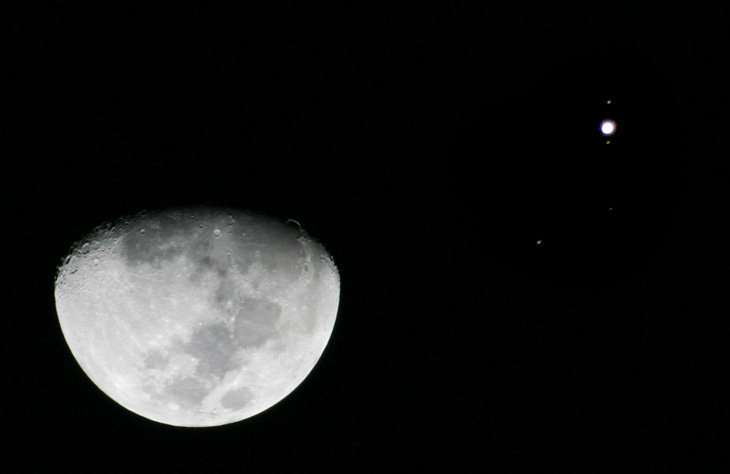It’s funny – as a species, we seem to have a propensity for discovery, to explore uncharted areas in the hope/belief that something magical awaits just over the horizon. It’s probably responsible for most of our explorations across the planet. There is definitely a cool feeling when you’re traveling, and you see a new and interesting place awaiting you on your path; while I have no idea how many people have actually experienced this, here are two of my examples.
While touring Florida over a decade ago, doing a photography vacation, I had an open itinerary and decided each day, sometimes by the hour, where I was going to head next. I have to admit that I have never had the faintest interest in going into Miami, though twice I had the displeasure of doing so anyway, so I was making the valiant attempt to bypass the city on the outskirts, something that the civic planners obviously felt was not in their best interests; there are no ‘through’ routes past Miami when coming up from the Keys, since all of them run a short ways north before turning directly east into the city. In order to avoid the hideous and overcrowded, quintessential urban blight of southeast Florida, you must keep exiting from the road that you are on before it draws you in, and get on another bypass lane, usually at the cost of a toll. After navigating my way through all of my small bills and pocket change, I had finally arrived with relief at the northern limits of the city sprawl, seeking the junction of Route 27 which would bear me northwest to Lake Okeechobee and, I hoped, something unconcretelike to photograph.
This turned out to be harder than imagined, since the exit looped around in a way that destroyed my bearings, and the signage that would lead me to Rt 27 was either inadequate or nonexistent, on purpose I suspect. While expecting to reach a junction with my intended route within a few kilometers, I ended up wasting an hour going into, and back out of, North Miami, not what people imagine when they think of Florida vacations, unless they think of Detroit. You know, motels with large wooden walls around the parking lots so no one can see your car while you park there for an hour or so? Yeah. When I finally reached Rt 27, I was tired and frustrated and eager to get to the lake.
Looking at it on a map now, the distance looks far less than what it seemed at the time, part of the subjectivity of memory I suppose. Rt 27 goes through Florida’s sugarcane industry, running very straight, flat, and featureless for long distances, something I was totally unfamiliar with in my travels well-removed from the western states. In other words, it’s boring, unrelieved by anything to look at, anyplace to stop, and any cars that would permit announcing their states of origin to oneself in a gibbering manner. I think a fox crossed the road once, but that was it. To make matters worse, darkness had settled in with triumph, broken only by my headlights and not the least sign of civilization. Yes, I know that was what I had just been decrying, but when you’re fatigued, a long straight dark road with no place to stop is not the best of choices. Not to mention that it’s where the extraterrestrials tend to hang out.
Eventually, when my estimates had told me I should be coming up on the settlements at the edge of Lake Okeechobee soon, I spied lights in the distance that were not headlights of a Driving Dutchman. Yes! Knowing that I would soon locate a place to bed down for the night, I watched them approach through, seriously, the longest distance I have ever seen something approach except for a storm. It took much longer than anticipated to get to this cluster of lights spelling a large town, which I had apparently spotted from fifteen klicks or so away. As I got closer, it seemed to be surprisingly compact, and also veering off to the left a bit. Quite a bit. I’m hoping you can imagine my feelings as, with the lights now almost three kilometers directly off to the west, I passed the sign which announced the entrance to the Okeelanta sugar processing plant. Visibly ahead on my route: nothing, yet again. That was a dirty trick, Florida.
A few years later, I was making an unplanned move to stay with a friend in Texas for a while, doing a hard drive from Atlanta to Houston in one go. I had just basic maps and had looked at them for only the correct interstates to be on, not bothering to calculate driving times between cities, for instance. Since I was now on I-10 and that led directly into Houston, I had little to do but keep driving.
In Louisiana, I had traversed a long section of elevated highway over stereotypical bayou country, where the road had to be raised on seven-meter columns because the gators could climb anything shorter – we’re not talking Starbucks and Apple Store country, here. Later on, after night had arrived, I reached a complicated cluster of interchanges and bridges where my path crossed a major river, and climbed a high suspension bridge that vaulted over big ship traffic. At the top, appearing before me from below as I crested the bridge, lay a towering Oz of glittering city lights, a metropolis of unexpected height and complexity. It was the kind of city that is imagined by artists and film directors, the sparkling lights on impressive buildings, rather than the overcrowding of industry that makes up most cities. I descended the bridge with this compelling sight awaiting me, a smalltown girl seeking her dreams in show business – well, okay, not quite, but you get the idea. It was exactly that kind of effect.
Suspicion set in when I realized that all of the lights were the same color, that curious amber of sodium lamps, and no lit windows of taller buildings were actually visible. It wasn’t long before this promising city revealed itself as a vast and surprisingly tall petroleum refining area, industrial development at its ugliest – I must have had the wind at my back. My fairy-tale experience of arrival kind of petered out at that point. A little tip, Louisiana Tourist Commission: run the interstates far from areas like that.
It has occasionally happened the other way around, too. Seeking out recommended spots for bird photography, I had ventured into Delray Beach, Florida and was driving through a heavily developed area liberally strewn with gated communities – it does make me wonder why anyone might move into a city and then sequester themselves away from everyone else, but hey. Locating my destination, I stopped in a parking lot typical of a strip plaza, with the discount shoe stores and Little Caesar’s Pizza replaced by a palm line. Quite often, decent nature photography spots have completely unfinished parking areas when they have any at all, so I was having some misgivings at this point – one does not typically seek high-traffic areas. I went up the wooden steps and crossed a boardwalk through the screening trees, and then the sound hit me.
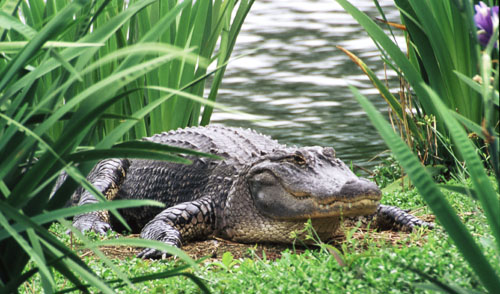 On the other side of the trees was a large wetlands area, and the cacophony of bird calls would have made a jungle movie Foley artist weep tears of joy. Nestled in the suburbs of West Palm Beach and Fort Lauderdale, Wakodahatchee Wetlands has to be heard to be believed, and I deeply regretted not bringing any recording equipment. While photography there requires a tolerance of speed walkers (see ‘gated communities’ above,) the birds, and a few other species, have adapted to their roles as models and present plenty of photo ops. While the most productive areas for nature photography tend towards undeveloped areas (fancy that,) this is a location that is often right on your route if you’re touring Florida, so easy enough to stop at.
On the other side of the trees was a large wetlands area, and the cacophony of bird calls would have made a jungle movie Foley artist weep tears of joy. Nestled in the suburbs of West Palm Beach and Fort Lauderdale, Wakodahatchee Wetlands has to be heard to be believed, and I deeply regretted not bringing any recording equipment. While photography there requires a tolerance of speed walkers (see ‘gated communities’ above,) the birds, and a few other species, have adapted to their roles as models and present plenty of photo ops. While the most productive areas for nature photography tend towards undeveloped areas (fancy that,) this is a location that is often right on your route if you’re touring Florida, so easy enough to stop at.
I also had misgivings while on the other side of the state. When your directions to a “great area” include turning off a major mid-city route into the entrance to the public works facility, you begin to think someone is either pulling your leg or hasn’t traveled much. You park by the sign and wander down the path (since then upgraded to a sidewalk) and see the island in the middle of a moderately-sized pond. And more wild birds in one location than you are likely to ever see anyplace else in the country. The Venice Audubon Society’s Rookery in Venice, Florida represents nesting conditions that you might think wouldn’t be so hard for birds to find farther from people, but the incredibly crowded conditions there belie that. If you’ve ever wanted to see herons and egrets in every stage of nesting and child-rearing at once, this is the place to go.
Anhingas are a species of waterfowl that are awkwardly named put most others to shame. Ducks, for instance, do not swim – they float on the surface and thrash about like a toddler with a pair of pool noodles. Anhingas occasionally surface for air. My first encounter with the species occurred at the Rookery, as the head of one popped from the water directly in front of me in a manner wholly reminiscent of the trash compactor monster from Star Wars, and just as brief. Later the same day I observed one glide in for a water landing and skid to a halt in a delicate wake – then vanish entirely, despite our distance from Bermuda. Time spent floating on the surface is just wasted, seems to be the attitude.
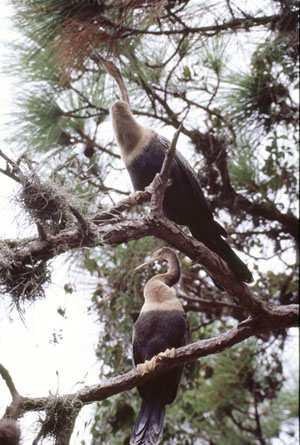 Confession here: I have a special connection with fire ants. Mind you, it is not a amiable one; I will not garner my own television show as some kind of Whisperer, though late night cable might pick me up as The Fire Ant Filthy Blasphemer. If they’re around, I will find them, usually by standing in the ant hill in sandals. And it was on the shore of the pond in Venice when I did this yet again. I had sideskipped away and removed my sandals, beating them mercilessly on the ground to dislodge the remaining ants and take out my frustration over the cluster of newly-arising burning welts, in a pointless yet satisfying manner, when I glanced up to see an anhinga sailing low over the water directly towards me at eye level. Nobody was around at the time to witness this, which is a shame, because this tableau deserves to be imagined at least. Me, kneeling on the ground in mid-invective with one sandal raised threateningly over my head, staring with concern at the rapid approach of a large bird with a beak like Macbeth’s dagger aimed at my skull. I had enough time to wonder if this was some kind of aggressive or protective display by a parent, enraged by my uncouth behavior, and if I was going to have a memorable encounter fending off a bird with totally inadequate footwear (spiked heels would have been at least sporting, but I tend not to wear them in public,) when the anhinga flared upwards into a stall and alighted in the tree directly over my head, immediately alongside another anhinga only two meters above whom I had missed entirely. They then carried on a loving yet croaking conversation while presenting the ludicrous spectacle of birds with webbed feet perching on a branch.
Confession here: I have a special connection with fire ants. Mind you, it is not a amiable one; I will not garner my own television show as some kind of Whisperer, though late night cable might pick me up as The Fire Ant Filthy Blasphemer. If they’re around, I will find them, usually by standing in the ant hill in sandals. And it was on the shore of the pond in Venice when I did this yet again. I had sideskipped away and removed my sandals, beating them mercilessly on the ground to dislodge the remaining ants and take out my frustration over the cluster of newly-arising burning welts, in a pointless yet satisfying manner, when I glanced up to see an anhinga sailing low over the water directly towards me at eye level. Nobody was around at the time to witness this, which is a shame, because this tableau deserves to be imagined at least. Me, kneeling on the ground in mid-invective with one sandal raised threateningly over my head, staring with concern at the rapid approach of a large bird with a beak like Macbeth’s dagger aimed at my skull. I had enough time to wonder if this was some kind of aggressive or protective display by a parent, enraged by my uncouth behavior, and if I was going to have a memorable encounter fending off a bird with totally inadequate footwear (spiked heels would have been at least sporting, but I tend not to wear them in public,) when the anhinga flared upwards into a stall and alighted in the tree directly over my head, immediately alongside another anhinga only two meters above whom I had missed entirely. They then carried on a loving yet croaking conversation while presenting the ludicrous spectacle of birds with webbed feet perching on a branch.
I cannot mention fire ants without relating another story. Riding with friends one night soon after a vicious thunderstorm (this is, again, in Florida,) there was a sudden plunk and a treefrog of immense proportions appeared suddenly on the windshield. They pulled over onto the grass immediately, and I got out to attempt to capture the frog for photographs, and because staying there while we got on the thoroughfare was probably not a wise move on the frog’s part. The amphibian abandoned its perch and hopped under the car, and I flopped down on my belly to try and retrieve it. In four seconds I had determined that it was out of reach, and also that my face and chest had suddenly produced an itching, burning sensation that I was all too familiar with. Just in case you were contemplating this experience, I will tell you that putting your face almost directly into a fire ant mound engenders no hidden charms. My friends eventually understood that I was not displaying a case of Sudden Onset Tourette’s Syndrome, but had an adequate reason, if not necessarily possessing adequate reason…
Since moving back to North Carolina I have been mercifully free of fire ant welts, but I suspect that they miss me and are working north in a dragnet. The last trip to Georgia clued me in on my remaining freedom, since despite my caution while walking through my friend’s yard, I still attracted the advance column – this is the only explanation, because no mound or colony was visible in the slightest. Their ambassadorial overtures resulted in the entire top of one toe turning into a water blister and preventing me from appearing in any kind of footwear commercials for weeks, and only adding to the abuse my foot took on that trip. I’m not joking; if you’re planning any research on fire ants, get in touch, because I will find them for you, and I might as well get paid for my skills. I am very understanding about the place of all species on this planet, but those little fuckers need to die and rot in hell.




















































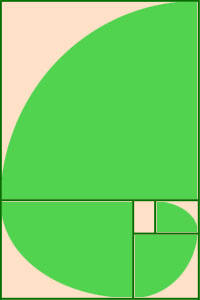 Why do I say that? Well, it’s simple. Try the same thing with the number 1.5 instead of 1.618. It would look like this. You can, in fact, use any ratio that you want and produce both a spiral and a nice descending composition, because that’s the nature of ratios – this isn’t anything profound. Phi is just neat: A/B=B/C.
Why do I say that? Well, it’s simple. Try the same thing with the number 1.5 instead of 1.618. It would look like this. You can, in fact, use any ratio that you want and produce both a spiral and a nice descending composition, because that’s the nature of ratios – this isn’t anything profound. Phi is just neat: A/B=B/C.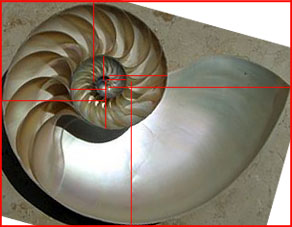 Now, I’ll be fair. Sometimes, there are some pretty close fits to mathematical ratios in nature, but this shouldn’t be surprising in the least. Organisms that produce the most efficient ‘designs’ obviously will thrive better than those with less efficiency, so the trend will be towards maximum efficiency. But the keyword there is “trend,” and obtaining an average from a cross-sampling of species can only provide useful information in specific circumstances. Using an image of a real nautilus shell (
Now, I’ll be fair. Sometimes, there are some pretty close fits to mathematical ratios in nature, but this shouldn’t be surprising in the least. Organisms that produce the most efficient ‘designs’ obviously will thrive better than those with less efficiency, so the trend will be towards maximum efficiency. But the keyword there is “trend,” and obtaining an average from a cross-sampling of species can only provide useful information in specific circumstances. Using an image of a real nautilus shell (